 I recently realized that I was missing a lot of what goes on around me when I’m fishing in the Chesapeake Bay due to weakened eyesight. Up to now, I’ve been purchasing drug-store reading glasses that I’d carry around in my tackle bag and drag out whenever I needed to tie on a lure. That worked fine until I started missing little details that my fishing partners were picking up on. I’ve always prided myself in being the first one on the boat to pick up working birds on the horizon. After almost a year of listening to others say, “Do you see those birds?,” I decided reading glasses aren’t enough, and it’s time to make the change to prescription glasses. Since I wear sunglasses most of the time when I’m fishing, I moved on to prescription sunglasses as well.
I recently realized that I was missing a lot of what goes on around me when I’m fishing in the Chesapeake Bay due to weakened eyesight. Up to now, I’ve been purchasing drug-store reading glasses that I’d carry around in my tackle bag and drag out whenever I needed to tie on a lure. That worked fine until I started missing little details that my fishing partners were picking up on. I’ve always prided myself in being the first one on the boat to pick up working birds on the horizon. After almost a year of listening to others say, “Do you see those birds?,” I decided reading glasses aren’t enough, and it’s time to make the change to prescription glasses. Since I wear sunglasses most of the time when I’m fishing, I moved on to prescription sunglasses as well.
 It turns out there’s a lot more to know about sunglasses than I thought. I went for many years using the cheapest sunglasses I could find. I’m paying for that mistake now with diminished vision and hypersensitivity to light. It all comes down to ultraviolet (UV) rays. Inexpensive, off-the-rack sunglasses provide very little or no UV protection. They darken your vision, but they don’t block the damaging rays. The darkening causes your iris to open wider than usual and allow more light, and therefore more UV rays, to injure your eyes. You don’t notice it so much when you’re young, but as you get older, it becomes a lot more obvious.
It turns out there’s a lot more to know about sunglasses than I thought. I went for many years using the cheapest sunglasses I could find. I’m paying for that mistake now with diminished vision and hypersensitivity to light. It all comes down to ultraviolet (UV) rays. Inexpensive, off-the-rack sunglasses provide very little or no UV protection. They darken your vision, but they don’t block the damaging rays. The darkening causes your iris to open wider than usual and allow more light, and therefore more UV rays, to injure your eyes. You don’t notice it so much when you’re young, but as you get older, it becomes a lot more obvious.
My search for the right sunglasses started with some background research about polarization. I learned that light waves normally enter our eyes from all directions. When light is reflected from a surface – like water – the waves orient themselves along a single, horizontal axis. When the waves line up, it’s called polarization and results in very bright concentrations of light. It’s not only harmful to the eye, but it can make it difficult to see clearly.
Polarized sunglasses reduce the intake of polarized light while allowing other light to enter normally, which effectively minimizes glare without darkening vision. For fisherman, this means that it is actually easier to see down into the water and identify things like fish and lures below the surface. Simply put, you need polarized glasses for fishing.
With that in mind, I set out on a search for the right lenses. Polarized glasses come with either plastic, polycarbonate, or glass lenses. I looked at the advantages and disadvantages of each.
The least expensive sunglasses have plastic lenses. The advantage of plastic is that it’s lightweight and durable. Plastic is a lot more resistant to impact, like from a flying jig head, than glass. Plastic is also less reflective than glass, so it cuts down on glare. The big disadvantage of plastic is that it is prone to scratching. Another disadvantage is that it expands and contracts depending on weather conditions. This can warp your field of vision and be a big problem when you wear prescription lenses.
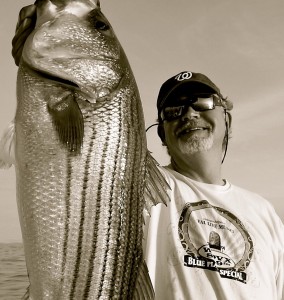 Glass lenses provide more clarity than plastic and are more resistant to scratching. Scratch resistance is important to fishermen because we frequently drop our sunglasses, or put them down on a deck seat or console, so it’s not unusual to see them sliding across the deck. Unfortunately, glass lenses are a lot heavier than plastic — twice as heavy in most cases. Glass lenses are also a lot more expensive than plastic and they’re more likely to crack or shatter with impact. If clarity is the most important factor to you, go with glass, but remember, there are trade offs.
Glass lenses provide more clarity than plastic and are more resistant to scratching. Scratch resistance is important to fishermen because we frequently drop our sunglasses, or put them down on a deck seat or console, so it’s not unusual to see them sliding across the deck. Unfortunately, glass lenses are a lot heavier than plastic — twice as heavy in most cases. Glass lenses are also a lot more expensive than plastic and they’re more likely to crack or shatter with impact. If clarity is the most important factor to you, go with glass, but remember, there are trade offs.
Polycarbonate lenses are relatively new to the market. The material was developed out of the space program and introduced in the 1980s as an alternative to glass or plastic. Polycarbonate lenses are a lot more impact resistant than plastic or glass and can rival glass in clarity. Unfortunately, they are more likely to scratch. As a result, sunglass manufacturers typically add a scratch resistant coating to polycarbonate lenses. These lenses can be a good choice for fishermen because of their durability, but only with the scratch resistant coating.
It’s also important to note that most sunglass manufacturers offer hybrid lens materials and proprietary polymers. Some lenses are made with a plastic-coating over glass. The combinations of materials have trademarked names that are frequently associated with the name of the manufacturer. The composition of these lenses is closely guarded, but they usually include polycarbonate variations.
 The next choice is color. What’s the best color for fishing? I learned that a lot depends on where and how you fish. Each color has advantages and disadvantages.
The next choice is color. What’s the best color for fishing? I learned that a lot depends on where and how you fish. Each color has advantages and disadvantages.
Yellowish tints typically allow in more light. This makes them an ideal choice for cloudy and overcast days. They also improve depth perception, but they can let in a lot of glare.
Amber, copper, or brown lenses block high amounts of blue light so they heighten contrast on sunny days and increase visibility when it’s overcast.
Darker-tinted lenses such gray and green offer the most light reduction and are ideal for very bright days. These colors do not distort perceived color as much as other lens colors do.
Blue lenses usually aren’t blue at all, but a gray or brown base enhanced by a blue reflective coating. If you like blue lenses, make sure the base color is not too dark because the coating can sometimes reduce contrast.
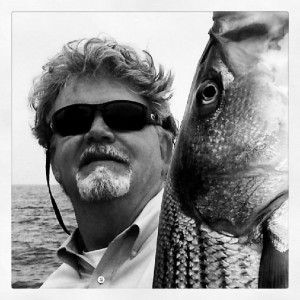 If you typically fish on days with high skies and bright sunlight, your best choice is to go with darker colors like gray or green. If you prefer to fish on darker days, or you spend a lot of time fishing in areas with heavy vegetation, go with a lighter color like green or brown.
If you typically fish on days with high skies and bright sunlight, your best choice is to go with darker colors like gray or green. If you prefer to fish on darker days, or you spend a lot of time fishing in areas with heavy vegetation, go with a lighter color like green or brown.
Now, there’s the challenge of incorporating your eyeglass prescription into your sunglass lenses. While prescription sunglasses are available in virtually any corrective prescription, not all prescription lenses are created equally. The better sunglass manufacturers use patented lens technologies to build your prescription into their proprietary lenses. There can be big variances in quality from one company to the next. Since there is a lot of competition in the prescription sunglass market, the technology has rapidly advanced and some of the better companies are now producing lenses that are of such high quality that they out-perform non-tinted prescription glasses. Check to be sure your name-brand sunglasses come with prescription lenses made by the company on the label. There are some businesses that will take name-brand frames and insert their own lenses. While this might be okay in some situations, as with all glasses, there is a lot of variation in lens quality.
 Almost all of the major sunglass brands can make single vision prescription sunglasses, but things get somewhat complicated if you need bifocal or progressive lenses. Progressive lenses are line-free multifocals that have a seamless progression of added magnifying power for intermediate and near vision. In other words, they have three fields of view, distant, intermediate, and near. A corridor of optimum lens power runs vertically down each progressive lens. Since almost all sunglasses have curved (wrap-around) lenses, that corridor can vary greatly from manufacturer to manufacturer.
Almost all of the major sunglass brands can make single vision prescription sunglasses, but things get somewhat complicated if you need bifocal or progressive lenses. Progressive lenses are line-free multifocals that have a seamless progression of added magnifying power for intermediate and near vision. In other words, they have three fields of view, distant, intermediate, and near. A corridor of optimum lens power runs vertically down each progressive lens. Since almost all sunglasses have curved (wrap-around) lenses, that corridor can vary greatly from manufacturer to manufacturer.
The differences in sunglass lens design are related mainly to the length and width of the progressive power corridors, and how much of each graduation is devoted to viewing distances. Different areas of the corridor may be expanded, depending on the design philosophy of the manufacturer and the intended purpose of the lens. If the optimum area of vision is too narrow, or doesn’t line up with your pupils, it can impair your vision and cause a “swimming” sensation that results in dizziness.
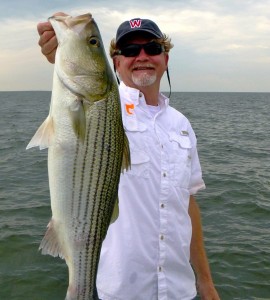 Some brands won’t even attempt progressive lenses in their wrap-around styles. The key here is to carefully research your options before you buy glasses, and my recommendation is to talk to a knowledgeable physician who understands your fishing lifestyle.
Some brands won’t even attempt progressive lenses in their wrap-around styles. The key here is to carefully research your options before you buy glasses, and my recommendation is to talk to a knowledgeable physician who understands your fishing lifestyle.
There’s obviously a lot of personal choice involved in purchasing fishing sunglasses. Finding a style and design that fits the way you fish can make a big difference in your success or failure on the water. Since I’m not in the business of endorsing products, I won’t tell you what brand I chose. I will say that I chose amber lenses because I like the added definition I get with the enhanced color contrast they provide. I also made sure I bought prescription lenses made by the company that manufactured the frames.
—
Fishing has really been fun over the past few weeks. I’ve recovered from my disastrous performance in the Kent Narrows Light Tackle Tournament with some very successful fishing days. I’ve been fishing both above and below Kent Island with good results in both locations. Last weekend I helped Lenny Rudow with a video series he’s working on called “GOT BAIT.” It was fun fishing with him and his 13-year-old twins Max and David. Those boys are crazy about fishing and their excitement is infectious. I also got to hang out with my fishing buddy Gary Reich who produced the episode. I’ll let you know when the video comes out.
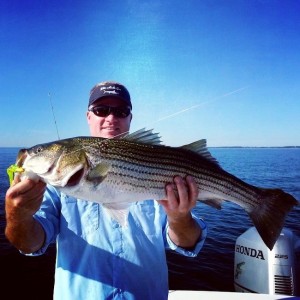 One evening last week I had the pleasure of hosting three guys who won a trip I donated last winter to the CCA Baltimore chapter. We launched from Matapeake and stayed on fish most of the evening. The action was fast and furious and we caught rockfish on both topwater and jigs with some chopper blues in the mix as well.
One evening last week I had the pleasure of hosting three guys who won a trip I donated last winter to the CCA Baltimore chapter. We launched from Matapeake and stayed on fish most of the evening. The action was fast and furious and we caught rockfish on both topwater and jigs with some chopper blues in the mix as well.
I’ve also been out a couple of evenings with my regular fishing partners Jamie and Rich. We’ve fished once south of Poplar Island and another time in the Upper Bay. We found a lot of suspended fish, but there are some nice schools relating to bottom structure as well. The key to successful fishing right now is finding good water. The bigger fish are suspending because they don’t like the quality of the water down deep. Younger fish are breaking in the early mornings, late evenings, and in low light situations. If you encounter breaking fish, be sure to mash the barbs on your lures and consider clipping off some of those trebles. It’s a lot better for the fish and it just might save you a trip to the hospital should one of those hooks wind up in your finger. We’re coming up on a very busy time of year on the Bay, and fortunately there are some very cooperative fish around. Good luck fishing!





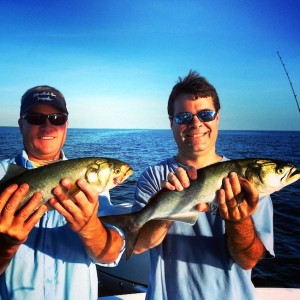
Shawn
My daughter loved the hat but is now hesitant to wear it for fear of getting it dirty and washing off the autograph. Your missing a great chance to poke fun at Lenny but it’s probably best not to give it away just yet.We enjoyed your talk at the CCA meeting last week and look foward to your next book.
Thanks for posting this…I have had a pair of Ray-Ban frames with prescription lenses for about 25 years. The lenses are single vision tinted in “Photo-Rose”… a red tint. I now require progressive lenses for my old man eyes and will probably be investing in another pair. I like the red tint as far as comfort goes, the red is soothing to the eyes and really cuts glare without darkening my vision. Many times I have fished ’til after dark, loaded the boat and drove half way home before I realized I still wearing them!
Started missing working birds and breaking fish 2 years back. Went to an eye surgeon at GBMC……had Cataracts. He removed them and put lens implants in my eyes.( Medicare covered it) Now have 20/20 plus vision for distance. Still need to carry on reading glasses for close-up. Doc. said I should def. be wearing polarized sunglasses in the sun after the cataract surgery etc.. to protect the eyes.
I like sunglasses. I own about 20 pairs. I still have Vuarnets from the 80s, although they rarely get worn. A pair in the truck, a pair in the car, a pair in my fly fishing bag, a pair in my saltwater bag, a pair in my freshwater bag, a pair on the boat, etc… It’s like women and shoes. I generally like brown lenses for overall use and Action Optics was my brand of choice for years.
I too am feeling the impacts of middle age on my vision. I read your article with great interest because I will soon need Rx sunglasses and cannot possibly afford to replace all of mine and for various reasons contact lenses are not a great option. Thanks for sharing and I might want to pick your brain around some of your specific findings.